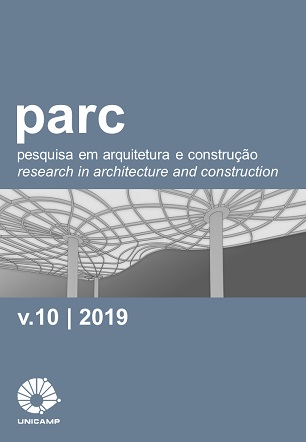Abstract
The aim of this paper is to present the results of research that seeks to develop simulations to assist architects and urban designers in planning interventions in outdoor spaces. This document will present the methods used to collect data of user dynamics and occupation in open and closed spaces, the patterns observed during the data collection process and a prototype of a simulation implemented using an autonomous agent library from Processing IDE. Open spaces around the University restaurant and atriums of classroom blocks of the Federal University of Santa Catarina are used as case studies. The simulations, represented in two dimensions, were developed to modify the agent’s dynamic by the insertion of new objects in an initial scenario and alteration of environmental parameters, such as temperature or situations of cloud or uncloud sky. The simulation presented in this paper focuses on the different conformation of groups of people, the spatial user flow and the behavior concerning other objects present in an outdoor space, such as trees and benches. The results from this research will assist us to develop tools to predict how patterns of human behavior in outdoor spaces and to assist students in developing their understanding of how small interventions can change the dynamic of a place.
References
BRAUN, A.; MUSSE, S. R.; OLIVEIRA, L. P. L. BODMANN, BARDO E. J. Modeling individual behaviors in crowd simulation. In: INTERNATIONAL CONFERENCE ON COMPUTER ANIMATION AND SOCIAL AGENTS, 16, 2003, New Brunswick. Proceedings […], New Brunswick: IEEE, 2003, p.143. DOI:https://doi.org/10.1109/CASA.2003.1199317
BUCKLAND, M. AI game programming by example. Tex.: Wordware, 2004.
GEHL, J. Life Between buildings: using public spaces. Washington: Island press, 2006.
GEHL, J.; SVARRE, B. How to study public space. Washington: Island Press, 2013.
GIBSON, J. The ecological approach to visual perception. Londres: Routledge. 1986.
GOFFMAN, E. Relations in Public: Microstudies of the Public Order. Nova York: Basic Books, 1971.
FRIEDENBERG, J.; SILVERMAN, G. Cognitive science: an introduction to the study of mind. California.: Sage Publications, 2006.
GRAHNA, P.; STIGSDOTTER, U. K. The relation between perceived sensory dimensions of urban green space and stress restoration. Landscape and Urban Planning, v. 94, Issues 3-4, p. 264-275, 2010. DOI:https://doi.org/10.1016/j.landurbplan.2009.10.012
KAPLAN, R.; KAPLAN, S. The experience of nature: a psychological perspective. New York: Cambridge University Press, 1989.
KENDON, A. Conducting interaction: patterns of behavior in Focused Encounters. Nova York: Cambridge University Press, 1990.
LAMBERTS, R.; HENSENAND, J. L. M. Building performance simulation for design and operation. New York: Spon Press, 2011.
LAWSON, B. Language of Space. Oxford: Architectural, 2001.
MARSHALL, P; ROGERS, Y; PANTIDI, N. Using F-formations to analyse spatial patterns of interaction in physical environments. In: THE 2011 ACM CONFERENCE ON COMPUTER SUPPORTED COOPERATIVE WORK, 14., 2011, Hangzhou, China. Proceedings [...]. Nova York: CSCW 11 Conference Committee, 2011, p. 445-454. DOI:https://doi.org/10.1145/1958824.1958893
MITCHELL, W. J. The logic of architecture. Cambridge, Mass.: MIT Press,1990.
SIMEONE, D.; KALAY, Y. E. An Event-Based Model to simulate human behaviour in built environments. In: ANNUAL CONFERENCE OF EDUCATION AND RESEARCH IN COMPUTER AIDED ARCHITECTURAL DESIGN IN EUROPE, 30., 2012, Praga. Proceedings […]. Praga: ECAADE, 2012, v.1, p. 525-532.
STINY, G. Shape: talking about seeing and doing. Cambridge, Massachusetts: MIT Press, 2006.
STINY, G.; GIPS, J. Shape grammars and the generative specification of paintings and sculpture. In C. V. Freiman, ed. Information processing 71, Amsterdam, 1972.
STINY, G. Pictorial and Formal Aspects of Shapes and Shape Grammars. Suiça: Birkhauser, 1975.
SHIFFMAN, D. The nature of code. California: Creative Commons, 2012.
VEITCH, R.; ARKKELIN, D. Environmental psychology: an interdisciplinary perspective. New Jersey: PrenticeHall, 1995.
WHYTE, W. H. The Social Life of Small Urban Spaces. Nova York: Project for Public Spaces,1971.
I accept that PARC Research in Architecture and Building Construction journal perform, on the original file approved for publication, revisions and modifications in orthoghaphic, grammar and standard issues.
I give to PARC Research in Architecture and Building Construction journal the rights of first publication of the revised version of my paper, licensed under the 'Creative Commons Attribution' license (which allows sharing the work with the recognition of first authorship and publication in this journal).

